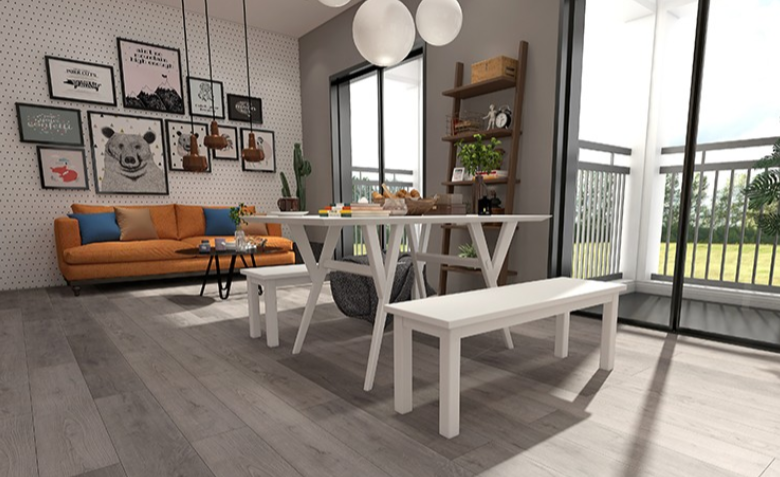
How Flooring Enhances the Prestige of Your Home, Restaurant, and Business
In the vast canvas of interior design, flooring often plays a role that is underestimated yet pivotal. It serves as the foundation upon which the entire ambiance and character of a space are built. From cozy homes to elegant restaurants and sophisticated business environments, the selection and installation of flooring silently elevate the quality and allure of every corner. This article delves into the art of choosing flooring that not only enhances but also transforms the atmosphere of your living spaces, making each one a unique and captivating masterpiece.

Residential Spaces: A Symphony of Warmth and Style
In the sanctuary of home, flooring transcends mere functionality; it becomes an extension of personality and style. The right choice can instill a sense of warmth and harmony, while also showcasing the homeowner’s refined tastes.
1. Material Matters:
- Solid Wood Flooring: Embodying the essence of nature, solid wood floors boast warm hues and intricate grain patterns, inviting a sense of tranquility and connection to the outdoors. They are the epitome of luxury and sustainability, perfect for those seeking a touch of authenticity in their living spaces.
- Engineered Wood & Laminate: Offering the aesthetic appeal of solid wood with added durability and affordability, these options cater to a wide range of design preferences. Their versatility in colors and textures ensures that every home can embody a unique personality.
- Carpets: Strategically placed carpets in living rooms or bedrooms add a layer of softness and warmth, creating intimate spaces for relaxation. They also offer excellent sound absorption, enhancing the overall comfort of the home.
2. Color & Pattern Play:
The color and pattern of flooring play a crucial role in setting the tone of a space. Light-colored floors expand the visual boundaries, making small apartments appear more spacious and bright. Conversely, darker hues exude a sense of sophistication and depth, ideal for larger spaces or those embracing a vintage aesthetic. Unique patterns, such as distressed wood or marble-effect tiles, add a touch of artistry and personality to any home.
Restaurant Spaces: Elegance Meets Appetite
Restaurants are where culinary delights meet social gatherings, and flooring plays a pivotal role in creating an inviting atmosphere.
1. Safety & Maintenance:
Non-slip flooring is paramount in restaurants to ensure the safety of patrons and staff. Easy-to-clean surfaces are also essential, given the high foot traffic and potential spills. Porcelain tiles or treated composite floors offer both safety and practicality.
2. Ambiance Creation:
- Minimalist Chic: Light-colored tiles or subtle wood tones paired with sleek furniture create a modern, uncluttered ambiance that appeals to a wide range of diners.
- Luxurious Retreats: High-end restaurants often opt for marble, polished wood, or intricate floor tiles that exude opulence and sophistication. Carefully curated lighting further enhances the dining experience, turning each meal into a memorable occasion.
3. Cultural Infusions:
Incorporating cultural elements into flooring design, such as traditional Chinese patterns on tiles or Spanish-inspired terracotta, adds depth and character to the restaurant, creating a unique identity that resonates with patrons.

Commercial Spaces: A Fusion of Professionalism and Aesthetics
Commercial spaces serve as the face of a brand, and flooring is a vital element in conveying its image and values.
1. Durability & Endurance:
With heavy foot traffic, commercial floors must withstand constant use while maintaining their aesthetic appeal. Reinforced flooring materials like vinyl composites, ceramic tiles, or high-quality hardwood offer both durability and style.
2. Brand Identity:
Flooring choices should align with the brand’s personality and values. A tech company might opt for sleek, modern flooring in cool tones, while a heritage brand might embrace warm, rustic woods to evoke a sense of tradition and trustworthiness.
3. Spatial Planning:
Flooring can be used to define functional areas within a commercial space, guiding customer flow and enhancing spatial efficiency. Color-coded zones or contrasting materials create visual boundaries that are both practical and aesthetically pleasing.
4. Creative Expressions:
Commercial floors can also serve as canvases for artistic expressions. Custom patterns, inlaid designs, or even interactive lighting effects can create stunning visual focal points that captivate visitors and reinforce the brand’s identity.
Flooring is more than just a surface upon which we walk; it is a powerful tool that shapes the ambiance, personality, and overall experience of our living, dining, and working spaces. By thoughtfully selecting materials, colors, patterns, and designs, we can elevate the prestige of our environments, turning them into inviting





Leave Your Comment